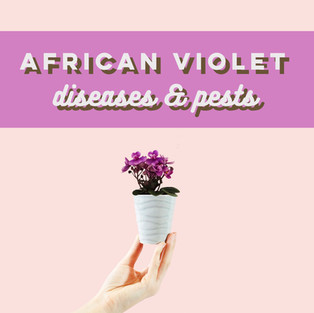How to Keep Your Mini African Violet Blooming
- Love Me Mini

- Oct 18, 2021
- 4 min read
African Violets are a favorite with their addictively fuzzy leaves and beautiful blooms. Some plant parents regard African Violets as one of their easiest plants, while others aren’t convinced. Are you having trouble getting your Mini African Violet to bloom?
This article contains Amazon Affiliate links. The price of the products stays the same, we receive just a little bit in return. Earnings from qualifying sales will help keep Lovememini.com up and running. Thank you so much for your support!
The #1 Reason Your Mini African Violet Isn’t Blooming
With the proper care, your Mini African Violet can bloom 365 days out of the year! That’s right: they aren’t limited by a blooming season or cycle, which is the case with other blooming houseplants. So what are they limited by? How well you take care of them.
African Violets require bright indirect light to bloom continuously. What does this really mean? Locate your plant in one of the brightest locations in your home; ideally, a windowsill that receives morning light and afternoon “shade.”
Providing Enough Light in Winter
Your Mini African Violet’s blooming requirements don’t change just because it’s winter! So, you’ll need to provide your plant with ample light if you want it to continue blossoming. The challenge? Days are shorter, and windowsills are chilly!
During cold months, remember that these plants require temperatures between 65-75 degrees and hate drafts. If your Mini African Violet is on a windowsill, you’ll likely have to relocate it.
Supplemental Light
What if you don’t have another location with bright indirect light? You can provide artificial light with a grow lamp (and no, they aren’t all as expensive or ugly as you might think).
Worst-case scenario: transport your African Violet to the brightest, warmest location you can muster. Even if it doesn’t bloom continuously throughout winter, it will reawaken in the spring!
The #2 Reason Your Mini African Violet Isn’t Blooming
Take a good look at the size of your African Violet’s container. Is it big? Small? African Violets will only bloom when they’re rootbound. Sure, we know: it’s so tempting to repot your plant once its leaves start getting big. But, it’s recommended that an African Violet’s foliage be 3x larger than its pot!
How often should I repot?
As with most houseplants, you should give repot your African Violet once a year to refresh its soil. Exhausted soil = poor nutrition and aeration; two things that are necessary for blooming!
This does not mean you should upgrade the pot size each year. There’s a good chance that your plant could be happy in its current pot for a few years in a row!
Other Reasons Why Your Mini African Violet Isn’t Blooming
If you’re confident in your Mini African Violet’s location and pot size, there are plenty of other reasons why your little friend isn’t reblooming! Any lapse in your care routine can throw your plant into a tantrum, so here are a few reminders on how to care for your Mini African Violet:
Watering
You should rewater your plant as soon as the soil is dry to the touch, usually every 7-10 days.
The watering method you choose is essential! You should never allow the foliage of your African Violet to get wet. Why? It can cause dieback, leaf spot, crown rot, and other disastrous diseases. How should you water your plant?
African Violets are perfect candidates for bottom watering, which ensures that all of the leaves stay nice and dry! New to this method? It’s pretty simple: Place your African Violet (pot and all) into a bowl of water that measures ½-¾ the height of the pot. Leave it to sit for 5-10 minutes. And you’re done!
Overhead watering your soil-only can also work for African Violets if you have a long-neck watering can.
Soil
While African Violets enjoy moist soil, soggy soil is a no-no. While you may connect “soggy soil” to your watering habits, it’s really a soil issue. You should plant your African Violet in a well-draining potting mix. Use African Violet mix or spruce up a traditional indoor potting mix with extra perlite.
Humidity
African Violets can survive in a wide range of humidity, but they thrive when the humidity levels are between 40-60%. The challenge? If you haven’t heard by now: Your average American household is around 10%. Not ideal.
Looking for ways to give your Mini African Violet a humidity boost so it will bloom? Don’t mist your plant. Remember, dry foliage is a must! Instead, find other ways to increase the ambient moisture. Like what?
A Humidifier: Filterless humidifiers aren’t as expensive as you may think. They’re easy to maintain and boast countless benefits to all your plant babies.
Grouping Plants: Plants are essentially mini humidifiers. They release most of the moisture they absorb back into the air. So, cluster several plants together!
A Pebble Tray: Purchase a water-tight decorative tray, fill it with pebbles, fill the tray midway with water, and place your African Violet on top.
Relocation: The bathroom and kitchen are the most humid rooms in your house. If there’s sufficient light, move your plant to one of these locations.
Deadheading
Once a flower is exhausted, it’s time to say goodbye! Removing spent blooms will help your Mini African Violet conserve the energy it needs to produce new blossoms. Simply snip the flower stalk to its base with clean scissors.
Remember: provide your African Violet with plenty of bright, indirect light. Keep them in a relatively small pot and give them the TLC they love! By doing all of this, your Mini African Violet will keep producing those addictively sweet blooms!
You Might Also Be Interested In...















Comments